1988 PONTIAC FIERO check engine
[x] Cancel search: check enginePage 837 of 1825
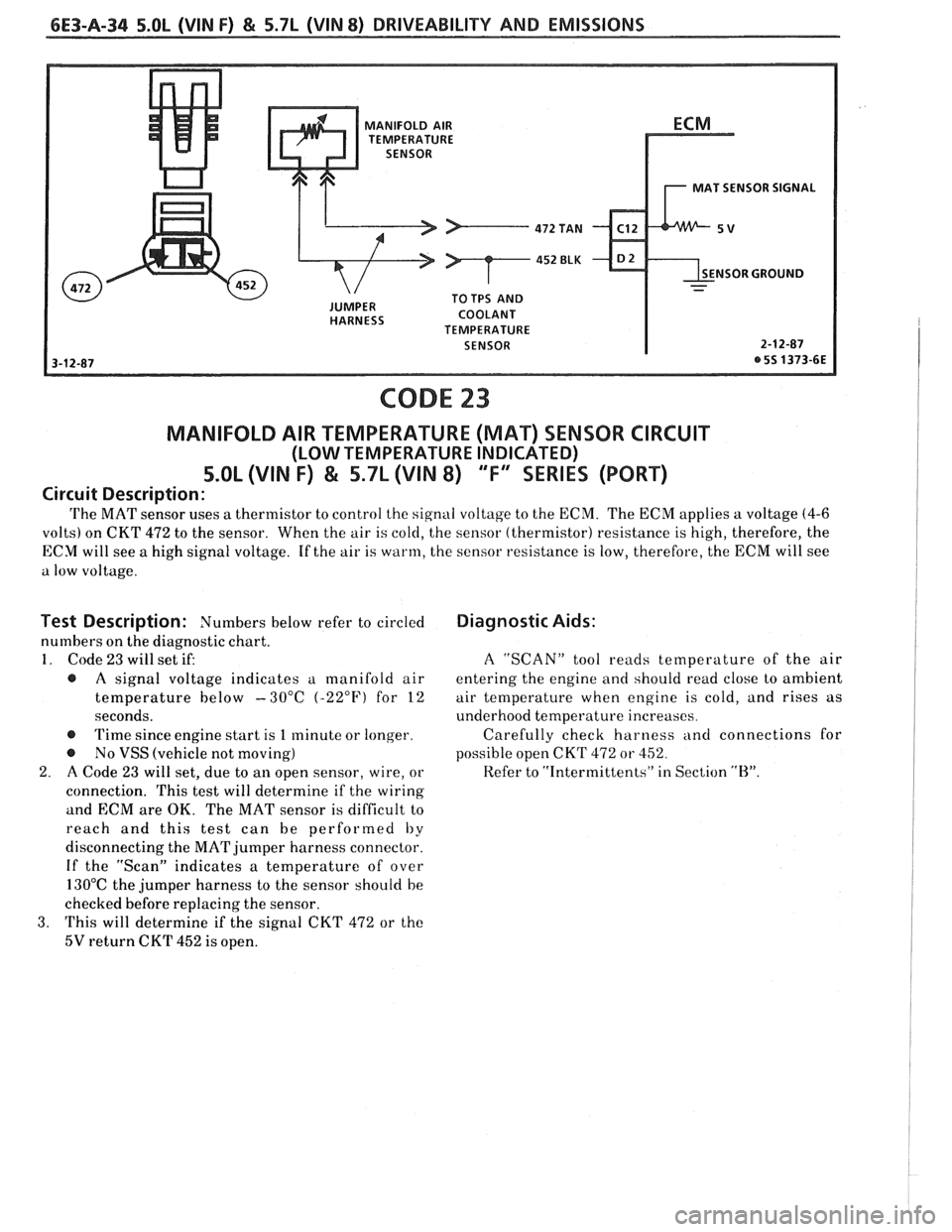
6E3-A-34 5.OL (VIN F) & 5.7L (VIN 8) DRIVEABILITY AND EMISSIONS
MANIFOLD AIR
TEMPERATURE
MAT SENSOR SIGNAL
NSOR GROUND
COOLANT
TEMPERATURE
SENSOR
CODE 23
MANIFOLD AIR TEMPERATURE (MAT) SENSOR CIRCUIT
(LOW TEMPERATURE INDICATED)
5.OL (VIN F) & 5.7L (VIN 8) "F" SERIES (PORT)
Circuit Description:
'I'he MAT sensor uses a thermistor to control the signal voltage to the ECM. The ECM applies a voltage (4-6
volts) on CKT 472 to the sensor. When the air is cold, the sensor (thermistor) resistance is high, therefore, the
ECY will see a high signal voltage. If the air is warm, the sensor resistance is low, therefore, the ECM will see
a low voltage.
Test Description: Numbers below refer to circled
numbers on the diagnostic chart.
1. Code 23 will set if:
@ A signal voltage indicates u manifold air
temperature below -30°C (-22°F) for
12
seconds.
@ Time since engine start is 1 minute or longer.
@ No VSS (vehicle not moving)
2. A Code 23 will set, due to an open sensor, wire, or
connection. This test will determine if the wiring
and ECM are OK. The MAT sensor is difficult to
reach and this test can be performed
by
disconnecting the MAT jumper harness connector.
If the "Scan" indicates a temperature of over
130°C the jumper harness to the sensor should be
checked before replacing the sensor.
3. This will determine if the signal CKT 472 or the
5V return CKT 452 is open.
Diagnostic Aids:
A "SCAN" tool reads temperature of the air
entering the engine and should read close to ambient
air temperature when engine is cold, and rises as
underhood temperature increases.
Carefully check harness
ancl connections for
possible open CKT
472 or 452.
Refer to "Intermittents" in Section
"H".
Page 839 of 1825

6E3-A-36 5.OL (VIN F) & 5.7L (VIN 8) DRIVEABILITY AND EMISSIONS
CONNECTOR
15- WAY .I.P. CONNECTOR - - PARK OR NEUTRAL
CODE 24
VEHICLE SPEED SENSOR (VSS) CIRCUIT
5.0L (VIN F) & S.SL (VIN 8) "F" SERIES (PORT)
rcuit Description:
'I'he ECM applies and monitors 12 volts on CKT 437. CK'I' 437 connects to the vehicle speed sensor buffer
which alternately grounds CKT 437 when drive wheels are turning. This pulsing action takes place about 2000
times per mile and the ECM will calculate vehicle speed based on the time between "pulses".
A "SCAN" tool reading should closely match with speedometer reading with drive wheels turning.
Test Description: Numbers below refer to circled
numbers on the diagnostic chart.
1. Code
24 will set it
@ CKT 437 voltage is constant.
@ Engine speed between 1400 and 3600 rpm.
@ Less than 2% throttle opening, about .10V
( 100mV) above close throttle.
@ Low load condition (low air flow).
@ Not in park or neutral.
@ All conditions must be met for 4 seconds.
'I'hese conditions are met during a road load
deceleration.
2. A voltage of less than 1 volt at the 15-way
connector indicates that the CKT 437 wire may be
shorted to ground. Disconnect CKT 437 at the VSS
buffer. If voltage now reads above 10 volts, the
VSS buffer is faulty. If voltage remains less than
10 volt, then CKT 437 wire is grounded
or open. If
437 is not grounded or open, check for a faulty
ECM connector or ECM.
Diagnostic Aids:
If "Scan" displays vehicle speed, check
parWneutra1 switch CHART C-1A on vehicle with
auto trans. If switch is
OK check for intermittent
connections. An open or short to ground in CKT 437
will result in a Code 24
If the customer also
complained about a loss of mph on the
I.P., check the
P.M. generator circuit. Refer to Section "8A" for
complete wiring diagram.
Refer to "Intermittents" in Section
"B".
Page 841 of 1825
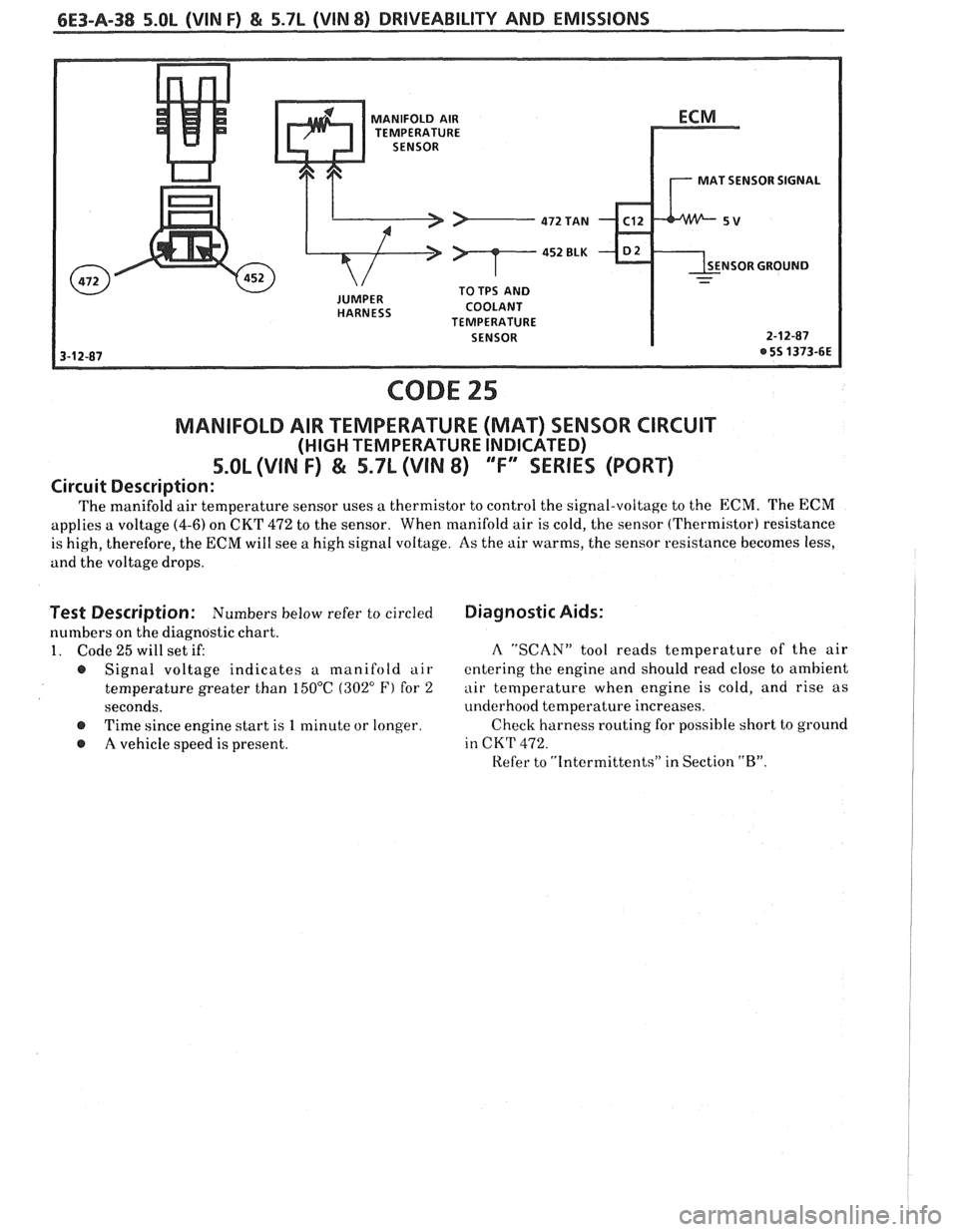
6E3-A-38 5.OL (VIN F) & 5.7L (VIM 8) DRIVEABILITY AND EMISSIONS
MANIFOLD AIR
TEMPERATURE
MAT SENSOR SIGNAL
NSOR GROUND
CODE 25
MANIFOLD AIR TEMPERATURE (MAT) SENSOR CIRCUIT
(HIGH TEMPERATURE INDICATED)
5.OL (VIN F) & 5.7L (VIN 8) 'T" "SERIES (PORT)
Circuit Description:
The manifold air temperature sensor uses a thermistor to control the signal-voltage to the ECM. The ECM
applies a voltage (4-6) on CKT 472 to the sensor. When manifold air is cold, the sensor (Thermistor) resistance
is high, therefore, the
ECM will see a high signal voltage. As the air warms, the sensor resistance becomes less,
and the voltage drops.
Test Description: Numbers below refer to circled
numbers on the diagnostic chart.
1. Code
25 will set if:
@ Signal voltage indicates a manifold air
temperature greater than 150°C
(302" F) for 2
seconds.
@ Time since engine start is 1 minute or longer.
@ A vehicle speed is present.
Diagnostic Aids:
A "SCAN" tool reads temperature of the air
entering the engine and should read close to ambient
air temperature when engine is cold, and rise as
underhood temperature increases.
Check harness routing for possible short
to ground
in CKT 472.
Refer to "Intcrmittents" in Section "B".
Page 843 of 1825
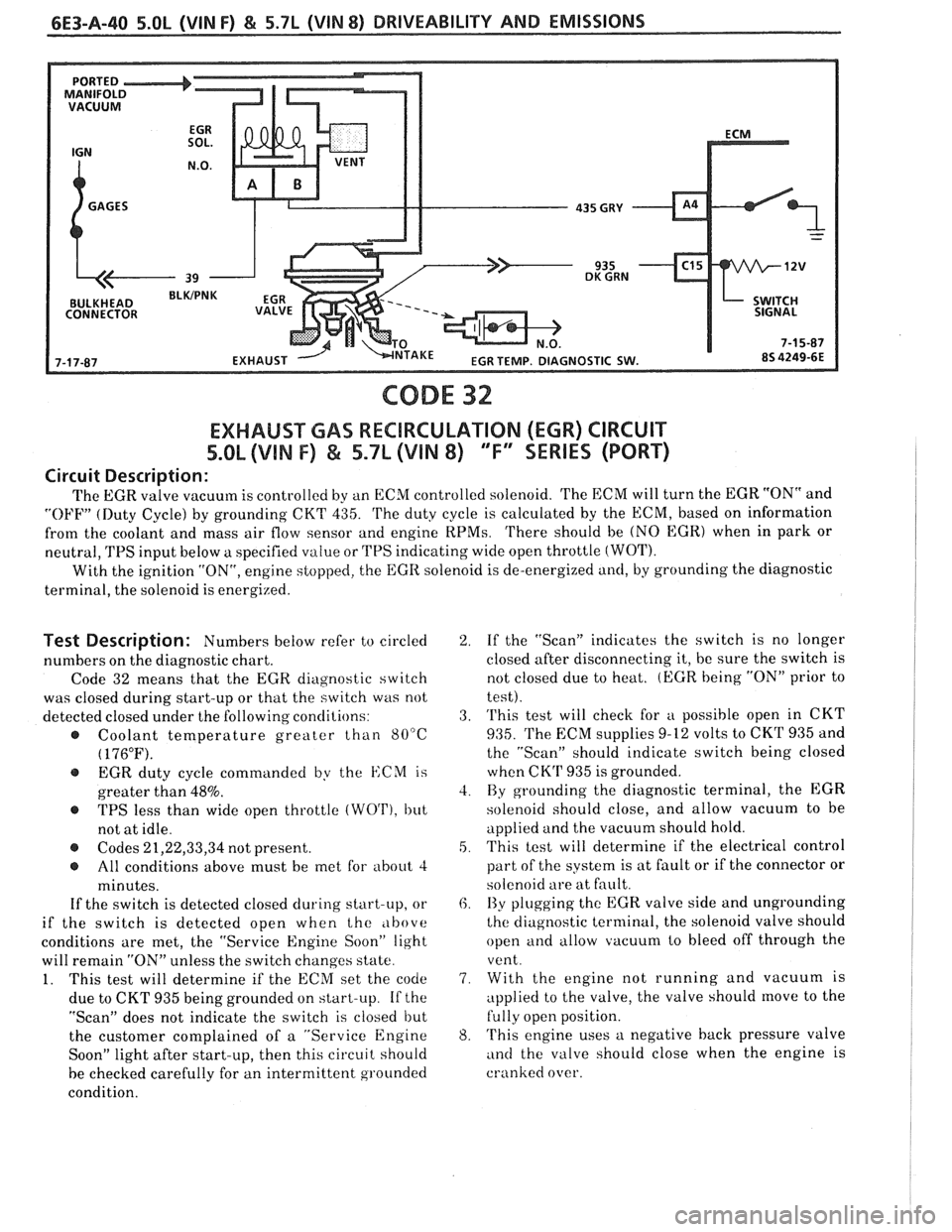
CODE 32
EXHAUST GAS RECBRCULATION (EGR) CIRCUIT
%.OL (VIN F) & 5.7L (VIN 8) "F" SERIES (PORT)
Circuit Description:
The EGR valve vacuum is controlled by an ECM controlled solenoid. 'I'he ECM will turn the EGR "ON" and
"OFF" (Duty Cycle) by grounding CKT 435. 'I'he duty cycle is calculated by the ECM, based on information
from the coolant and mass air flow sensor and engine
RPMs. 'I'here should be (NO EGR) when in park or
neutral,
TPS input below a specified value or TPS indicating wide open throttle (WOT).
With the ignition "ON", engine stopped, the EGR solenoid is de-energized and, by grounding the diagnostic
terminal, the solenoid is energized.
Test Description: Numbers below refer to circled
numbers on the diagnostic chart.
Code 32 means that the
EGR diagnostic switch
was closed during start-up or that the switch was not
detected closed under the following conclilions:
@ Coolant temperature greater than 80°C
( 176°F).
@ EGR duty cycle commanded by the ISCM is
greater than
48%.
@ TPS less than wide open throttle (WO'I'), but
not at idle.
@ Codes 21,22,33,34 not present.
@ All conditions above must be met for about 4
minutes.
If the switch is detected closed during start-up, or
if the switch is detected open when the
,lbove
conditions are met, the "Service Engine Soon" light
will remain
"ON" unless the switch changes state.
1. This test will determine if the ECM set the code
due to CKT 935 being grounded on start-up.
If the
"Scan" does not indicate the switch is closed but
the customer complained of a "Service Engine
Soon" light after start-up, then this circuit should
be checked carefully for an intermittent grounded
condition.
2. If the "Scan" indicates the switch is no longer
closed after disconnecting it, be sure the switch is
not closed due to heat.
(EGR being "ON" prior to
test).
3. 'I'his test will check for
u possible open in CKT
935. 'I'he EXM supplies 9-12 volts to CKrl' 935 and
the "Scan" should indicate switch being closed
when CK'P 935 is grounded.
4. By grounding the diagnostic terminal, the EGR
solenoid should close, and allow vacuum to be
applied and the vacuum should hold.
5. This test will determine if the electrical control
part of the system is at fault or if the connector or
solenoid are at fault.
6. I3y plugging the EGR valve side and ungrounding
the diagnostic terminal, the solenoid valve should
open and allow vacuum to bleed off through the
vent.
7. With the engine not running and vacuum is
applied to the valve, the valve should
move to the
fully open position.
8. 'I'his engine uses a negative back pressure valve
and the valve should close when the engine is
cranked over.
Page 845 of 1825
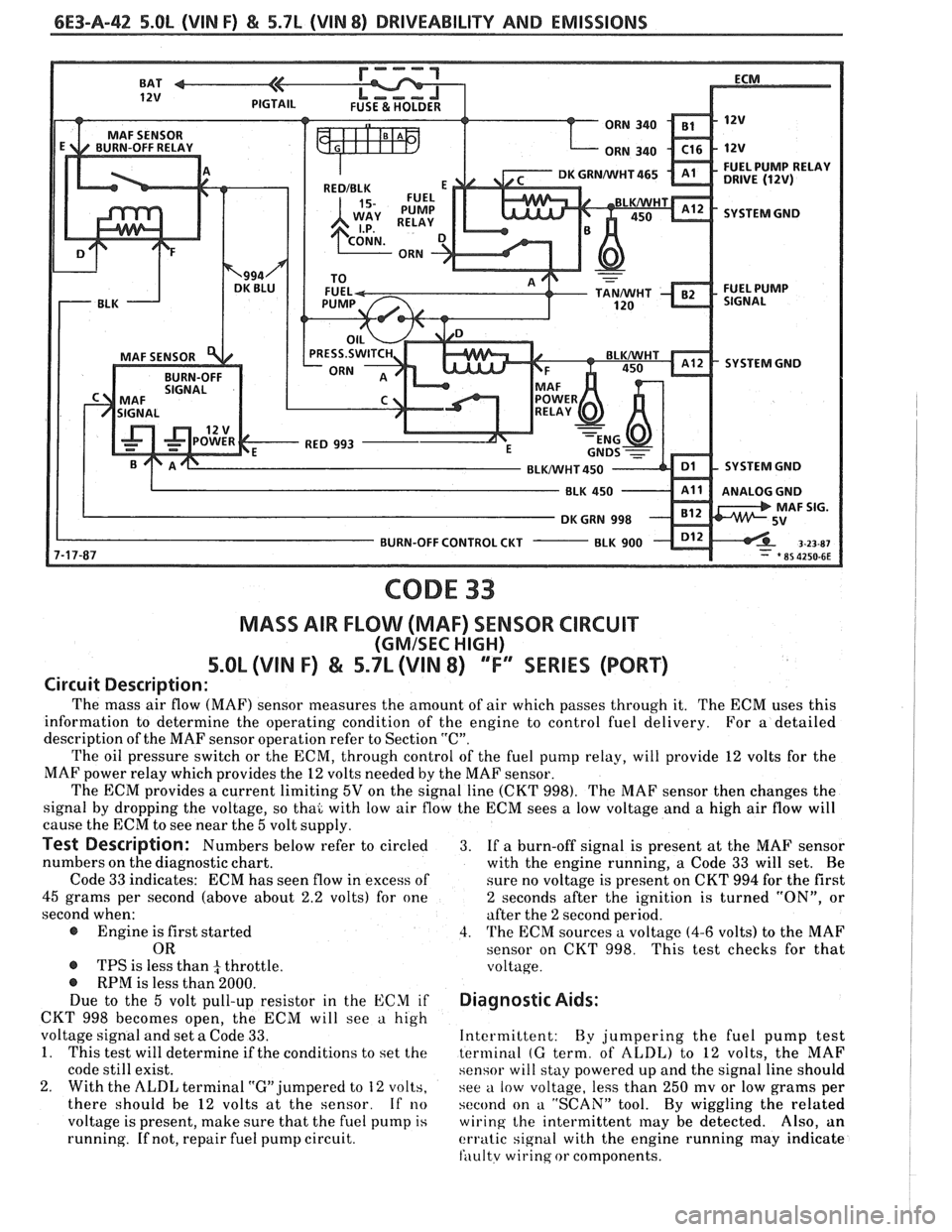
6E3-A-42 S.OL (VIN F) & 5.7L (VIN 8) DRIVEABILITY AND EMISSIONS
SYSTEM GND
SYSTEM GND
SYSTEM GND
ANALOG GND
BURN-OFF CONTROL CKT
-
CODE 33
MASS AIR FLOW (MAF) SENSOR CIRCUIT
(GMISEC HIGH)
5.OL (VIN F) & 5.7L (VIN 8) ""FY"IES (PORT)
Circuit Description:
The mass air flow (MAF) sensor measures the amount of air which passes through it. The ECM uses this
information to determine the operating condition of the engine to control fuel delivery.
For
a detailed
description of the MAF sensor operation refer to Section
"C".
The oil pressure switch or the ECM, through control of the fuel pump relay, will provide 12 volts for the
MAF power relay which provides the
12 volts needed by the MAF sensor.
The ECM provides
a current limiting 5V on the signal line (CKT 998). The MAF sensor then changes the
signal by dropping the voltage, so thai with low air flow the ECM sees
a low voltage and a high air flow will
cause the ECM to see near the
5 volt supply.
Test Description: Numbers below refer to circled 3. If a burn-off signal is present at the MAF sensor
numbers on the diagnostic chart.
with the engine running, a Code
33 will set. Be
Code
33 indicates: ECM has seen flow in excess of
sure no voltage is present on CKT 994 for the first
45 grams per second (above about 2.2 volts) for one 2 seconds after the ignition is turned "ON", or
second when: after the
2 second period.
@ Engine is first started 4. The ECM sources a voltage (4-6 volts) to the MAF
OR sensor on CKT 998. This test checks for that
@ TPS is less than 4 throttle. voltage. @ RPM is less than 2000.
Due to the 5 volt pull-up resistor in the ECM if Diagnostic Aids:
CKT 998 becomes open, the ECM will see a high
voltage signal and set
a Code 33. Intermittent:
By jumpering the fuel pump test
1. This test will determine if the conditions to set the terminal (G term, of ALDL) to 12 volts, the MAF
code still exist. sensor will stay powered up and the signal line should
2. With the ALDL terminal "G" jumpered to 12 volts,
see a low voltage, less than 250 mv or low grams per
there should be
12 volts at the sensor. If no second on a "SCAN" tool. By wiggling the related
voltage is present, make sure that the fuel pump
is wiring the intermittent may be detected. Also, an
running.
If not, repair fuel pump circuit. erratic signal with the engine running may indicate
fili~ltv wirinq or components.
Page 847 of 1825
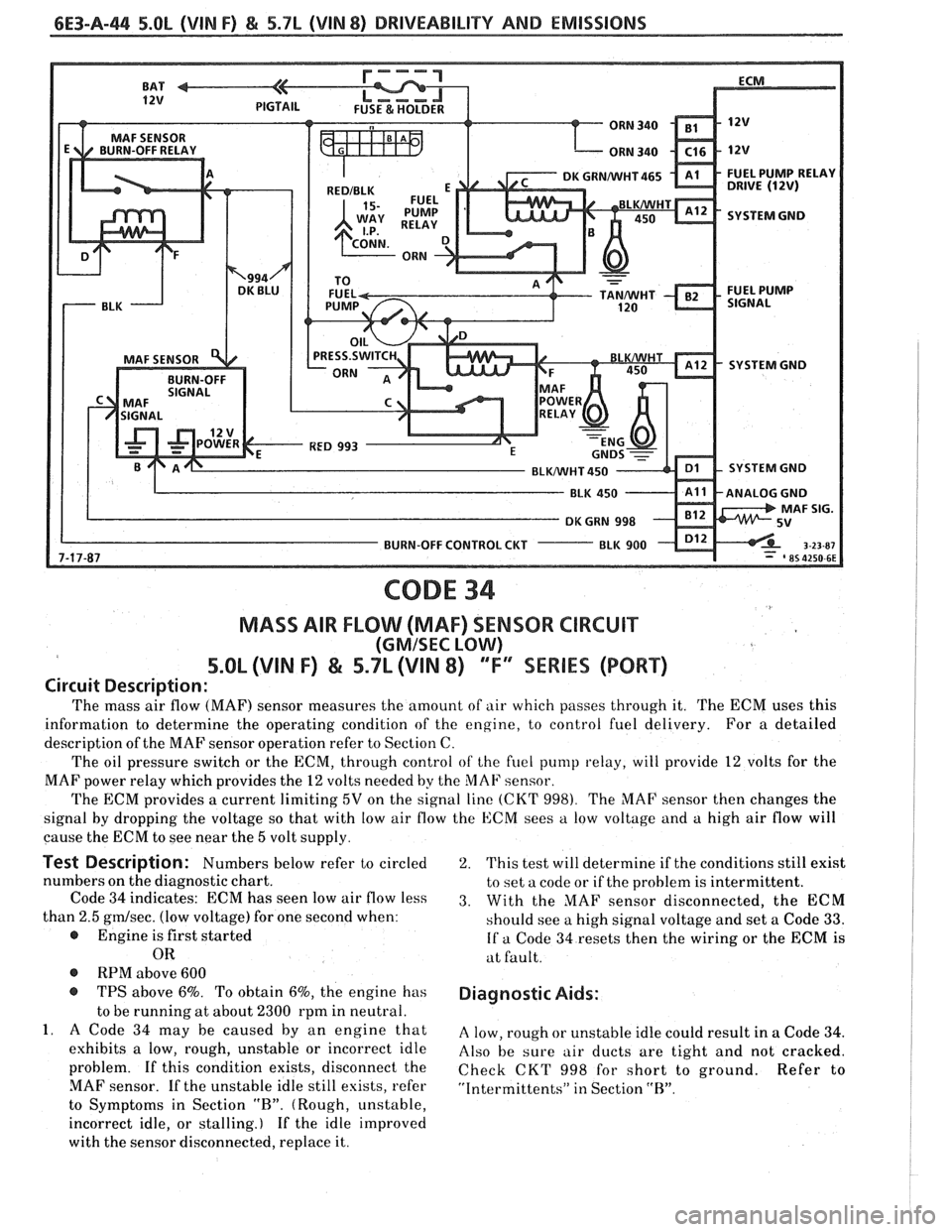
6E3-A-44 5.0b (VIN F) & 5.7L (VIN 8) DRIVEABILITY AND EMISSIONS
SYSTEM GND
SYSTEM GND
BLUNVHT 450 SYSTEM GND
BURN-OFF CONTROL CUT
CODE 34
MASS AIR FLOW (MAF) SENSOR CIRCUIT
(GMISEC LOW)
5.OL (VIN F) & 5.7L (\/IN 8) "F"" SERIES (PORT)
Circuit Description:
The mass air flow (MAF) sensor measures the amount of air which passes through it. The ECM uses this
information to determine the operating condition of the engine, to control fuel delivery. For a detailed
description of the MAF sensor operation refer to Section C.
The oil pressure switch or the ECM, through control
of the fuel pump relay, will provide 12 volts for the
MAF power relay which provides the
12 volts needed by the MAF sensor.
The ECM provides a current limiting
5V on the signal line (CKT 998). The MAF sensor then changes the
signal by dropping the voltage so that with low air flow the ECM sees
a low voltage and a high air flow will
cause the ECM to see near the
5 volt supply.
Test Description: Numbers below refer to circled
numbers on the diagnostic chart.
Code
34 indicates: ECM has seen low air flow less
than
2.5 gmlsec. (low voltage) for one second when:
@ Engine is first started
OR
@ RPM above 600
@ TPS above 6%. To obtain 6%, the engine has
to be running at about
2300 rpm in neutral.
1. A Code 34 may be caused by an engine that
exhibits a low, rough, unstable or incorrect idle
problem. If this condition exists, disconnect the
MAF sensor. If the unstable idle still esists, refer
to Symptoms in Section
"R". (Rough, unstable,
incorrect idle, or stalling.) If the idle improved
with the sensor disconnected, replace it.
2. This test will determine if the conditions still exist
to set a code or if the problem is intermittent.
3. With the MAF sensor disconnected, the ECM
should see a high signal voltage and set a Code
33.
If a Code 34 resets then the wiring or the ECM is
at fault.
Diagnostic Aids:
A low, rough or unstable idle could result in a Code 34.
Also be sure air ducts are tight and not cracked.
Check CKT
998 for short to ground. Refer to
"Intermittents" in Section "R".
Page 849 of 1825
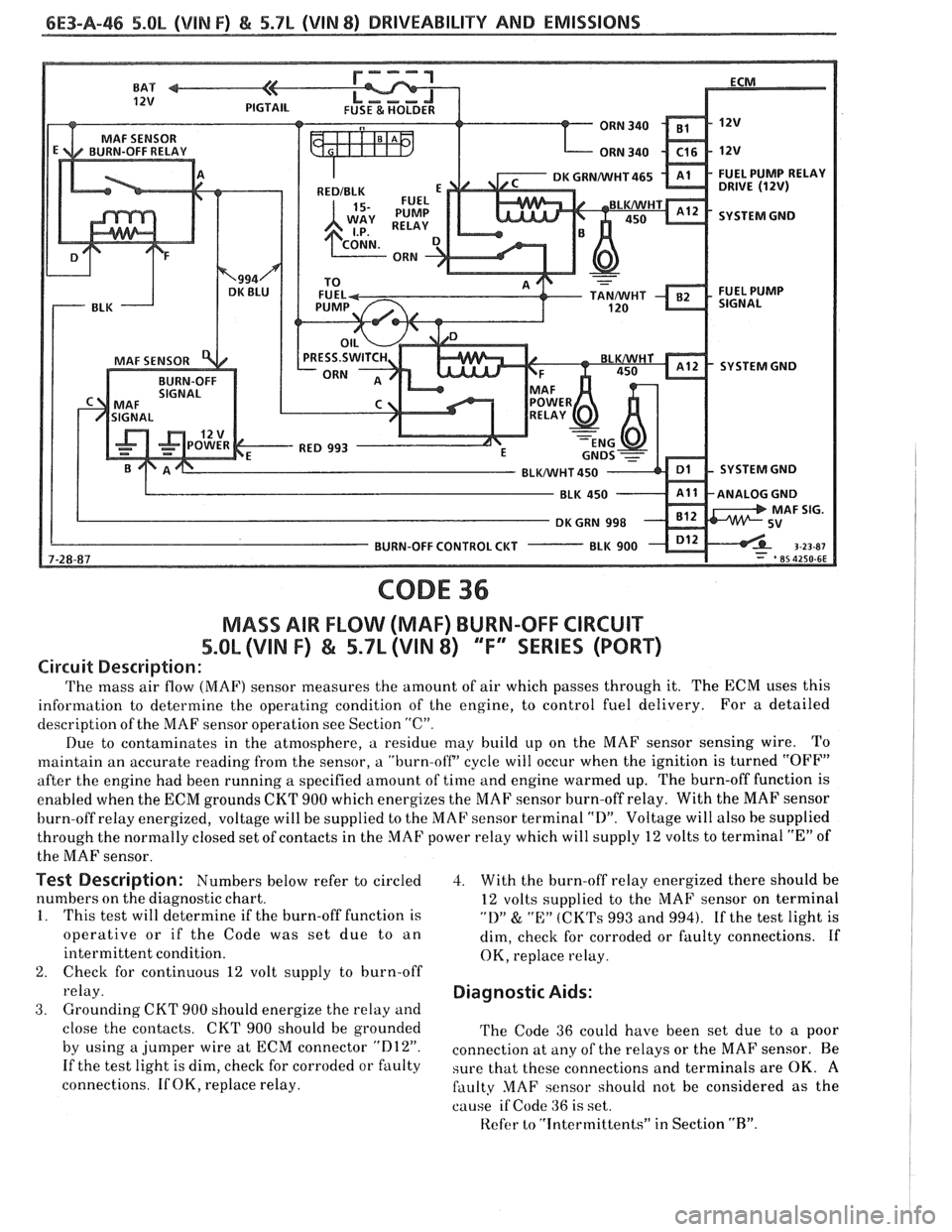
6E3-A-46 5.Ob (VIN F) & 5.7b (VIN 8) DRIVEABILITY AND EMISSIONS
SYSTEM GND
SYSTEM GND
SYSTEM GND
CODE 36
MASS AIR FLOW (MAF) BURN-OFF CIRCUIT
5.Qh (VlN F) & 5.7L (VIN 8) ""F9SERlES (PORT)
Circuit Description:
The mass air flow (MAF) sensor measures the amount of air which passes through it. The ECM uses this
information to determine the operating condition of the engine, to control fuel delivery. For
a detailed
description of the MAF sensor operation see Section
"C".
Due to contaminates in the atmosphere, a residue may build up on the MAF sensor sensing wire. To
maintain an accurate reading from the sensor, a "burn-off' cycle will occur when the ignition is turned "OFF"
after the engine had been running a specified amount of time and engine warmed up. The burn-off function is
enabled when the ECM grounds
CKT 900 which energizes the MAF sensor burn-off relay. With the MAF sensor
burn-off relay energized, voltage will be supplied to the MAF sensor terminal
"D". Voltage will also be supplied
through the normally closed set of contacts in the MAF power relay which will supply 12 volts to terminal
"E" of
the MAF sensor.
Test Description: Numbers below refer to circled
numbers on the diagnostic chart.
1. This test will determine if the burn-off function is
operative or if the Code was set due to an
intermittent condition.
2. Check for continuous 12 volt supply to burn-off
relay.
3. Grounding CKT 900 should energize the relay and
close the contacts. CKT 900 should be grounded
by using a jumper wire at ECM connector
"D12".
If the test light is dim, check for corroded or faulty
connections. If OK, replace relay.
3. With the burn-off relay energized there should be
12 volts supplied to the MAF sensor on terminal
"1)" & "E:" (CK'I's 993 and 994). If the test light is
dim, check for corroded or faulty connections. If
OK, replace relay.
Diagnostic Aids:
The Code 36 could have been set due to a poor
connection at
any of the relays or the MAF sensor. Be
sure that these connections and terminals are OK.
A
faulty MAF sensor should not be considered as the
cause
if Code 36 is set.
Refer
to "intermittents" in Section "R".
Page 851 of 1825
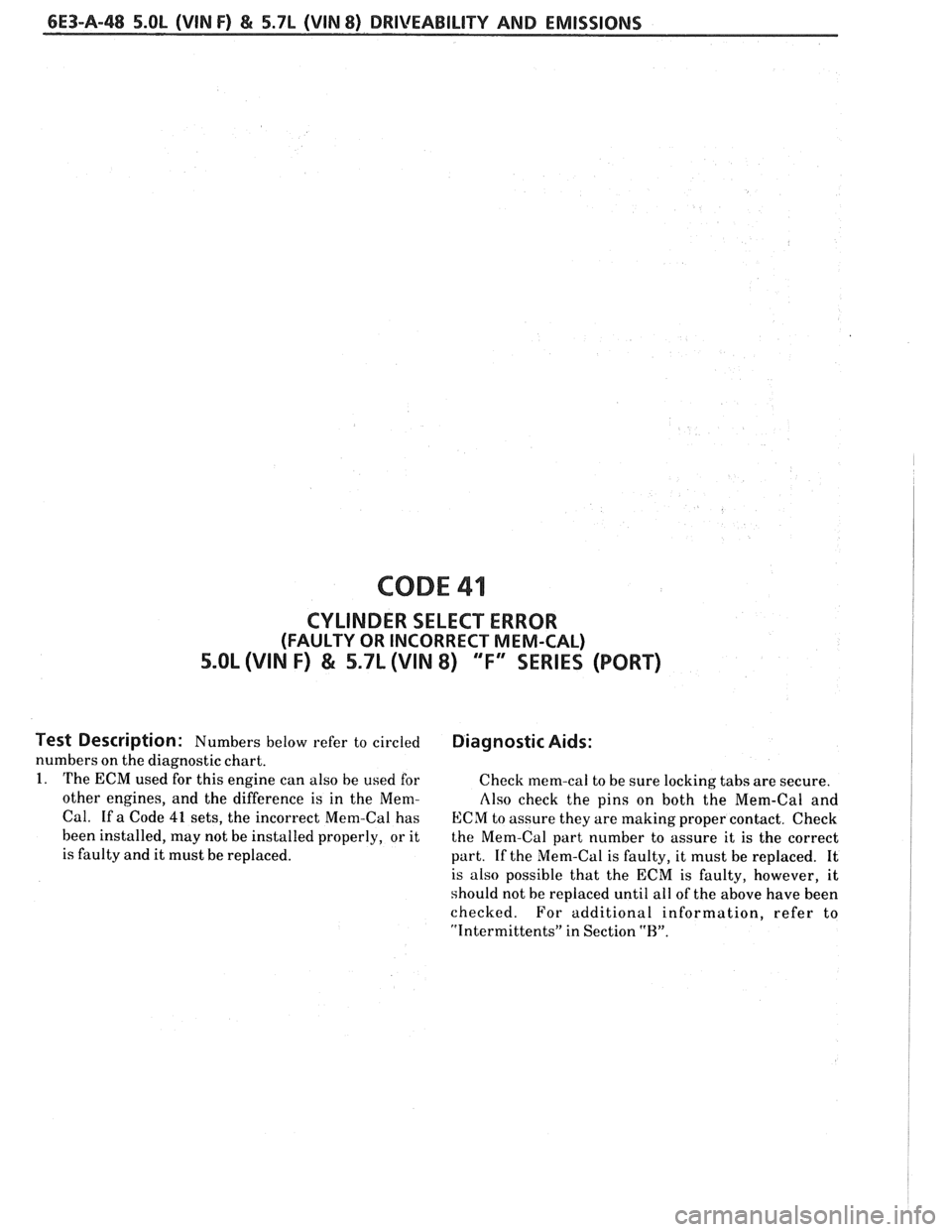
6E3-A-48 5.OL (VIN F) & 5.7L (VIN 8) DRIVEABILITY AND EMISSIONS
CODE 41
CYLINDER SELECT ERROR
(FAULTY OR INCORRECT MEM-CAL)
5.OL (VIN F) & 5.7L (VIN 8) "F" SERIES (PORT)
Test Description: Numbers below refer to circled Diagnostic Aids:
numbers on the diagnostic chart.
1. The ECM used for this engine can also be used for
Check mem-cal to be sure locking tabs are secure.
other engines, and the difference is in the Mem-
Also check the pins on both the Mem-Cal and
Cal. If a Code 41 sets, the incorrect Mem-Cal has
ECM to assure they are making proper contact. Check
been installed, may not be installed properly, or it
the Mem-Cal part number to assure it is the correct
is faulty and it must be replaced.
part. If the Mem-Cal is faulty, it must be replaced. It
is also possible that the ECM is faulty, however, it
should not be replaced until all of the above have been
checked. For additional information, refer to
"Intermittents" in Section
"H".